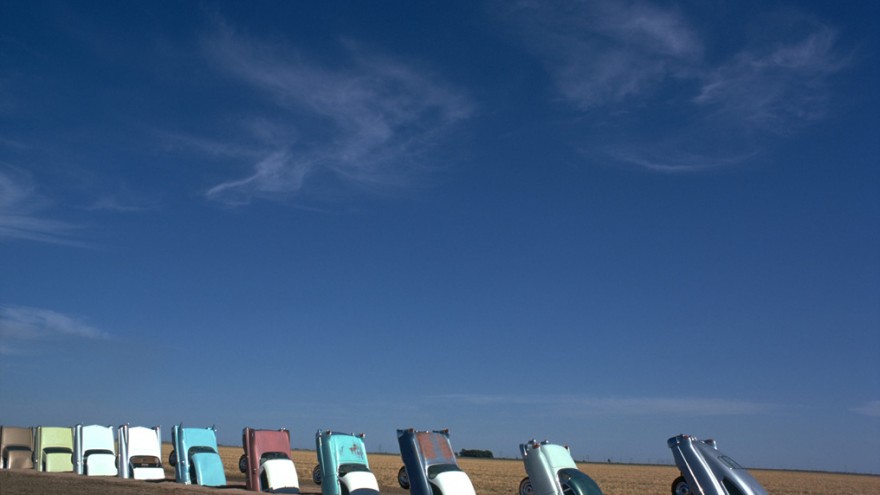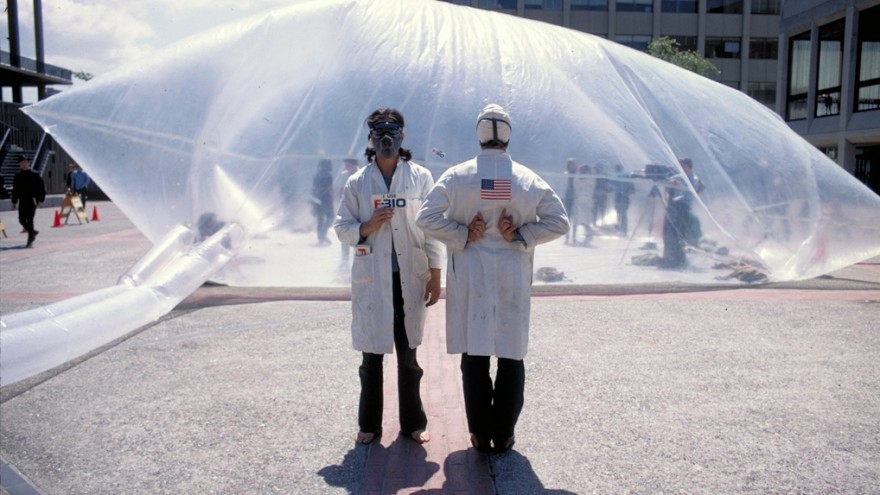They half-buried Cadillac cars in the ground in Texas, at an angle that corresponds to that of the Great Pyramid of Giza. This was in 1974. In 1975 they dressed up as astronauts and drove a space-age Cadillac through a wall of flaming TV sets at full speed. They also re-enacted the assassination of John F Kennnedy in a video clip called the Eternal Frame, focussing on the event as a crucial site of fascination and repression in the American mindset.
They are Ant Farm, a renegade 1970s architecture collective founded in 1968 in San Francisco by Chip Lord and Doug Michels. As well as being an avant-garde architecture practice, Ant Farm also worked in graphic art, environmental design practice, video and served as cultural commentators. Their antics soon earned the title “the Merry Pranksters of architecture”. Even the name “Ant Farm" is derived form their antics. Having described the nature of their work to a friend as “underground architecture”, she is said to have responded by saying: “Oh underground architecture is what ants do”, and from there the name.
Ant Farm described themselves as an “art agency that promotes ideas that have no commercial potential but which we think are important vehicles of cultural introspection”. Their ideas and actions were crazy and counter-cultural for the time, but commented on society in a way that made people think and question the status-quo.
Space, Land and Time, an independent documentary film by Laura Harrison and Elizabeth Federici is the first to document the antics of Ant Farm. Subtitled “Underground Adventures with Ant Farm” the film comprises archive footage, interviews and animation. Space, Land and Time is also a portrait of a bygone era and way of life which serves as crucial context for Ant Farm’s work.
See Space, Land and Time at the Design Indaba Filmfest at the Freeword Design Centre on Sunday 20 February at 20:30 and on Tuesday 22 February at 18:30.
Design Indaba asked filmmaker Laura Harrison a couple of questions:
What inspired the making of the film?
This film happened because of a serendipitous, life-changing encounter. We met Doug Michels, one of the founding members of Ant Farm, more than ten years ago. At the time, he was teaching at the University of Houston in the architecture department. He was truly one of the most creative and original thinkers I've ever had the pleasure of knowing. I had studied Art History in college and knew about Ant Farm's Cadillac Ranch and Media Burn from a seminar on 20th century art movements, so I was amazed and thrilled to learn that Doug was one of the creative masterminds behind these remarkable projects. When he proposed that we get involved with the opening of the Houston Time Capsule piece in 2000, we jumped at the chance to participate. What started out as a short film about that one Ant Farm work grew over the next few years into a feature length documentary about the entirety of their ten-year collaboration. Doug's untimely death in 2003 made us resolve to push through and finish the film, even though it took another seven years to do so!
What was the most challenging part of making the film?
Probably the fact that it took us ten years to complete! It's hard to stay focused and motivated for such a long period of time, even though in truth we both had other projects we made during those years as well. The other big challenge was finding money. There's not a lot of money out there to begin with, and having such an unusual topic definitely made the task of finding funders even more challenging. But we persisted and eventually found grants and individuals who believed in the project.
What did you enjoy about it the most?
The best part about making this film was getting to know and hang out with the Ant Farmers and their many collaborators! It continues to be a singular pleasure to share the stage with them at festivals and other screenings. We've learned so much from them and are extremely grateful for their incredible generosity. Among many other things, they gave us access to their entire archives without cost, we would never have had the budget to pay for all the fantastic footage and images they loaned us. The Ant Farmers were also great examples to us in the more challenging moments; they never gave up on a project, so how could we?
What has the general reaction to the film been like?
Audiences everywhere have been really inspired by the film. We find that young architects and designers who view the film are moved to go out and create cutting edge projects that push past the conventional boundaries of their disciplines. And frankly, everyone loves the free-spirited joy of creation that pervades in everything they ever did. It's wonderful to be able to expose a whole new generation of viewers to Ant Farm's beautiful work and prescient ideas about the world.
Who, in your opinion, is the target audience for the film?
We made the film with two audiences in mind: young architects and designers, and general art-loving viewers who frequent museums and galleries. And as it turns out, these are indeed the audiences we tend to find at most screenings. Plus a lot of people who lived through that era (the 1970s) and are thrilled to re-visit the beauty and spirit of those times.








